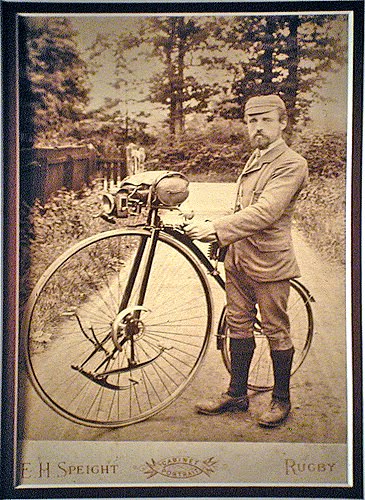A distinctive chain ring, yesterday.
The weld is not a thing of beauty.
This means that the chain line is slightly off being pushed inboard by the width of the chain ring. The cranks are also monstrously long at 7" (~178 mm) between centres, this was fashionable at the time but my knees have never thanked me for it. I much prefer cranks in the 165-170 mm range.
The solution is to keep the old cranks safe with the bike but make a new pair for riding purposes. The thought of owning a bike that I can't or don't ride is anathema to me, this is why I'm going to so much trouble making new parts for the bike. As I mentioned last time, when I emigrated from the UK about a hundred years ago, I bought everything with me, even rusty old crank sets. This was fortuitous as decent quality old parts are very hard to find in New Zealand. From the hoard I selected a pair of 6.5" (~165 mm) Williams C34 cranks. They had rust pits and not much chrome left and were the ideal donors.
20 minutes in HCl acid to remove the chrome and rust and I could begin to start work. First I need to remove the spider, this is swaged on over a toothed interface.
I milled off just enough material to allow the spider to come off
and still allow me to room to mount the new chain ring.
The Williams date code stamped into the cranks identified them as 1956, 50 years after the Enfield. Cranks had changed little in that half century but a few minor details needed correcting. The Williams cranks had a few weight saving bevels cut into them that the Enfield did not, these needed to be filled with weld and then re profiled back.
Weight saving bevels...
...not saving weight.
The shape of the cranks has also subtly changed over the years, earlier cranks have a much more abrupt transition between the pedal boss and the shaft and between the axle boss and the shaft. This is easier to remedy as taking off metal is always easier than putting it on again. Half an hour playing with some files and the transitions are now of the older Edwardian profile.
unmodified on the left, original in the middle and re profiled on the right...
...and the same at the pedal boss
Then the edge bevel needs to be replaced...
... to make it appear original.
At the same time, I got rid of the last of the nickel plating. Hydrochloric acid makes short work of chrome but won't touch the nickel substrate. This is very handy is you want to make something look older than it really is by exposing the nickel but means that you have to remove the nickel by other means.
The original cranks bear the legend "ENFIELD CYCLE CO LTD TOUGHENED CRANK" stamped into them.
ENFIELD CYCLE CO LTD TOUGHENED CRANK.
Stamping guides.
I couldn't do the Co. & Ltd. exactly as per the original.
In years to come somebody may wonder about that.
The last stamping is the left and right hand thread around the pedal holes. Again I needed to make a little jig to guide the punches, this took a little thought to get something that worked well. I can't stand doing mono buttocked jobs, I'd much rather spend the time and do it right. But that's just me being all OCD I suppose.
Left Hand Thread.
Next week I'll make the chain ring. I've made a few chain rings before and while not difficult, they do take a bit of time if made by hand. I'm sure I could get the plate laser or water cut in a fraction of the time and if I was making more than one I'd probably do it. However including the time taken to draw up the chain ring in CAD, I'm pretty sure I could have the one ring smashed out by hand in the same time.
In other news, we've bought a rowing machine. To say that my giant son is into rowing would be like mentioning that I quite like cycling a bit. Being winter here (the solstice was just a few days ago) there is almost no rowing on the rivers at the moment. He does go and use the "ergs" at his club for the social aspect but living in the middle of nowhere makes it quite hard to do too often. Also my lovely wife and giant daughter have expressed interest from a fitness point of view. A very short conversation with my son about what to buy and a short time later we have a Concept2 Model E in our living room. Apparently, there is only one erg to get if you are serious about it. I've also been using it myself although quite timidly as my back does not like new things that involve bending too much. We shall see how it works out.






























